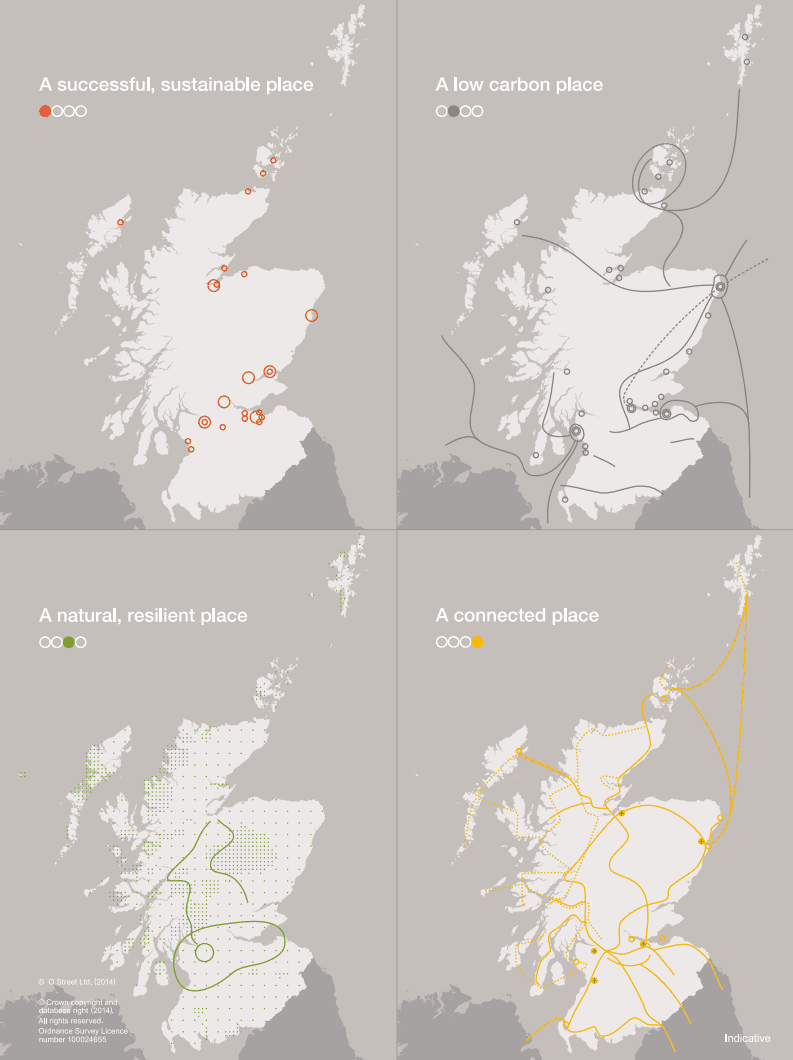National Planning Framework 3
The third National Planning Framework, setting out a long-term vision for development and investment across Scotland over the next 20 to 30 years.
1. Our spatial strategy

Using the maps in this document: Strategy maps are provided for each of the four themes included in the document: a successful, sustainable place, a low carbon place, a natural, resilient place and a connected place and the national developments. A fold-out key is provided for each of the full size individual maps.
Ambition, Opportunity…
1.1 The Scottish Government's central purpose is to create a more successful country, with opportunities for all of Scotland to flourish, through increasing sustainable economic growth. To achieve this, the Government Economic Strategy aims to share the benefits of growth by encouraging economic activity and investment across all of Scotland's communities, whilst protecting our natural and cultural assets.
1.2 Our vision is a Scotland which is:
- a successful, sustainable place. We have a growing low carbon economy which provides opportunities that are more fairly distributed between, and within, all our communities. We live in high quality, vibrant and sustainable places with enough, good quality homes. Our living environments foster better health and we have reduced spatial inequalities in well-being. There is a fair distribution of opportunities in cities, towns and rural areas, reflecting the diversity and strengths of our unique people and places.
- a low carbon place. We have seized the opportunities arising from our ambition to be a world leader in low carbon energy generation, both onshore and offshore. Our built environment is more energy efficient and produces less waste and we have largely decarbonised our travel.
- a natural, resilient place. Natural and cultural assets are respected, they are improving in condition and represent a sustainable economic, environmental and social resource for the nation. Our environment and infrastructure have become more resilient to the impacts of climate change.
- a connected place. The whole country has access to high-speed fixed and mobile digital networks. We make better use of our existing infrastructure, and have improved internal and international transport links to facilitate our ambition for growth and our commitment to an inclusive society.
1.3 Our spatial strategy shows where there will be opportunities for growth and regeneration, investment in the low carbon economy, environmental enhancement and improved connections across the country. It indicates where we expect most change to happen, from our city regions to rural areas and coastal towns.
… Place
1.4 Scotland is a diverse country. Our national spatial strategy provides a flexible framework for sustainable growth and development which reflects the varied assets of our many distinctive places.
1.5 Scotland's seven city regions are home to the majority of our population and economic activity. In the coming years, our cities network will continue to be a focus for investment. We will build on the collective strengths of the city regions and on the opportunities which are unique to each. We aim to transform cities into models of low carbon living, supporting growth, addressing regeneration and improving connections. Many of our largest and most vibrant towns are located close to our cities.
Our spatial strategy provides a growth and development agenda for each of our city regions, and highlights where infrastructure investment will be a priority. Many nationally important developments are located in or close to our cities.
1.6 A sustainable, economically active rural area, which attracts investment and supports vibrant, growing communities, is essential to our vision. Within this, we recognise the collective national importance of our networks of rural towns and villages. We are committed to safeguarding our natural and cultural assets and making innovative and sustainable use of our resources.
Our spatial strategy provides a vision for sustainable growth and development across rural Scotland, and highlights the role of some of our rural towns in achieving this. Our rural areas are diverse - but this strategy sets an agenda that will be shared by communities from the south of Scotland to the northern Highlands and Islands.
1.7 Scotland's varied coast and islands have an exceptional, internationally recognised environment. They now have an unprecedented opportunity to secure growth from renewable energy generation as well as other key economic sectors including tourism and food and drink. In our more remote areas, this will bring new employment, reverse population decline and stimulate demand for development and services. Infrastructure investment, including improved transport and digital links and a planned approach to development, will be required to support this change and realise this potential.
Our spatial strategy emphasises the importance of our islands and coast as an economic opportunity and a resource to be protected and enjoyed. Many coastal and island towns act as transport and service hubs and provide a focal point for investment and growth.
Contact
Email: Dr Fiona Simpson
There is a problem
Thanks for your feedback